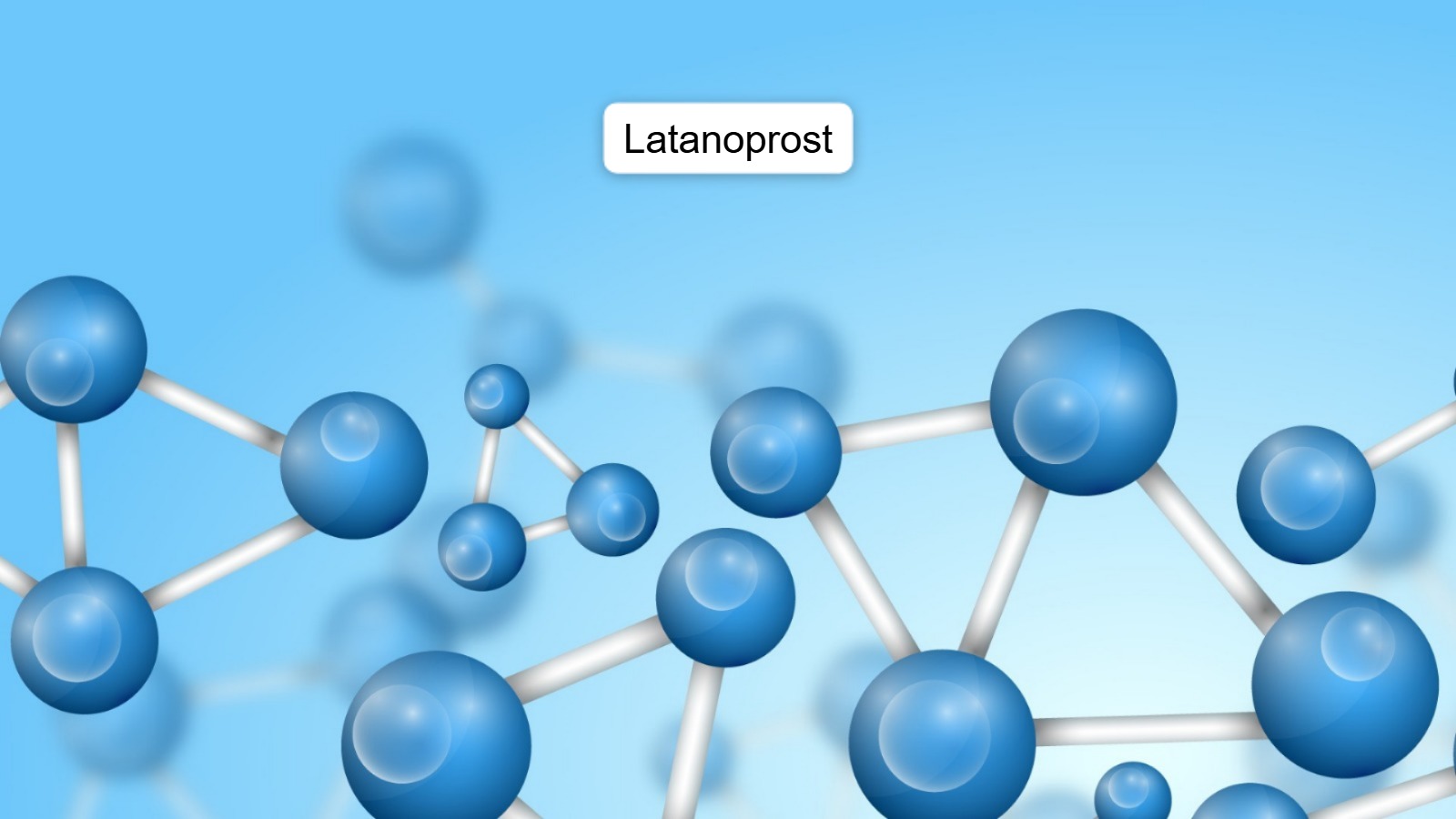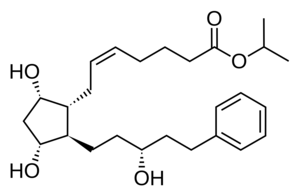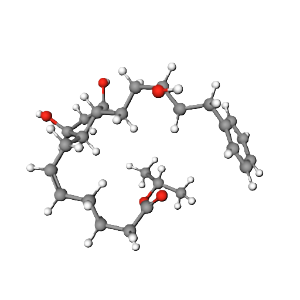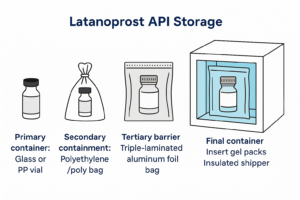
Latanoprost is a prostaglandin analog widely used for managing glaucoma and ocular hypertension. Its unique mechanism of action, favorable safety profile, and chemical stability make it a preferred medication for reducing intraocular pressure. This guide explores the structure, properties, pharmacology, uses, and safety of Latanoprost.
1. Structure of Latanoprost
The molecular structure of Latanoprost explains its efficacy in treating ocular hypertension and glaucoma.
2D Structure
The 2D structure of Latanoprost features a prostaglandin F2α analog backbone with modifications that enhance its receptor-binding affinity and increase its stability in ocular tissues.

3D Structure
The 3D conformation of Latanoprost shows its ability to selectively bind to FP receptors in the ciliary body. This interaction facilitates aqueous humor outflow, reducing intraocular pressure effectively.

2. Names and Identifiers
Latanoprost API is recognized under various names and identifiers across medical and pharmacological databases.
- IUPAC Name:
Isopropyl (Z)-7-{(1R,2R,3R,5S)-3,5-dihydroxy-2-[(3R)-3-hydroxy-5-phenylpentyl]cyclopentyl}hept-5-enoate - Molecular Formula:
C26H40O5 - Molecular Weight:
432.59 g/mol - CAS Registry Number:
130209-82-4 - Synonyms:
Xalatan, Monoprost
These identifiers facilitate the recognition and classification of Latanoprost.
3. Chemical and Physical Properties
The chemical and physical properties of Latanoprost contribute to its therapeutic applications.
| Property | Details |
|---|---|
| Appearance | Clear, colorless to slightly yellow liquid |
| Melting Point | Not applicable (liquid form) |
| Solubility | Soluble in ethanol and methanol; sparingly soluble in water |
| LogP (Partition Coefficient) | ~3.8 |
| Chemical Class | Prostaglandin Analog |
These properties make it ideal for ophthalmic formulations.
Explore a leading manufacturer of APIs.
With over 10 years of expertise, we ensure GMP compliance and provide reliable, high-quality solutions.
4. Drug and Medication Information
Latanoprost is widely used to lower intraocular pressure in patients with glaucoma or ocular hypertension.
Formulations
- Ophthalmic Solution:
- Available as 0.005% eye drops.
Mechanism of Action
Latanoprost works by:
- Increasing Uveoscleral Outflow: Enhances the drainage of aqueous humor from the eye, reducing intraocular pressure.
- Targeting FP Receptors: Selectively binds to prostaglandin receptors in the eye’s ciliary muscles, facilitating fluid outflow.
Dosage and Administration
- Recommended Dose:
- Apply one drop to the affected eye(s) once daily in the evening.
Overuse may reduce its effectiveness.
- Apply one drop to the affected eye(s) once daily in the evening.
Follow your doctor’s instructions for optimal results.
5. Pharmacology and Biochemistry
Latanoprost’s pharmacology highlights its efficacy as a glaucoma treatment.
Pharmacokinetics
- Absorption:
Rapidly absorbed through the cornea after topical administration. - Onset of Action:
Reduces intraocular pressure within 3-4 hours, with peak effects at 8-12 hours. - Half-Life:
~17 minutes in plasma. - Excretion:
Primarily eliminated via urine.
Pharmacodynamics
Latanoprost mimics the action of prostaglandin F2α, improving aqueous humor outflow to reduce intraocular pressure. Its targeted mechanism ensures minimal systemic effects.
6. Uses and Side Effects
Primary Uses
- Open-Angle Glaucoma:
Prevents optic nerve damage by lowering intraocular pressure. - Ocular Hypertension:
Reduces elevated intraocular pressure to prevent vision loss.
Benefits
- Long-lasting effects with once-daily dosing.
- Proven efficacy in reducing intraocular pressure.
- Minimal systemic absorption, ensuring a favorable safety profile.
Side Effects
Common side effects include:
- Eye redness or irritation.
- Increased pigmentation of the iris (may be permanent).
- Eyelash growth or darkening.
Rare but serious side effects:
- Swelling of the macula (macular edema).
- Severe eye pain or vision changes.
Consult your doctor if side effects persist or worsen.
7. Safety and Hazards
Safety Profile
Latanoprost API is safe for most patients when used as directed. However:
- Contraindications: Avoid use in patients with hypersensitivity to Latanoprost or its components.
- Pregnancy and Breastfeeding: Use with caution and only under medical supervision.
Chemical Safety

Handling Precautions
- Store in a refrigerator before opening; after opening, store at room temperature for up to 6 weeks.
- Avoid touching the dropper tip to prevent contamination.
Environmental Impact
Latanoprost has minimal environmental persistence and is safe when disposed of according to medical guidelines.
FAQs
IUPAC Name of Latanoprost?
Isopropyl (Z)-7-{(1R,2R,3R,5S)-3,5-dihydroxy-2-[(3R)-3-hydroxy-5-phenylpentyl]cyclopentyl}hept-5-enoate.
Molecular Formula of Latanoprost?
C26H40O5
Molecular Weight of Latanoprost?
432.59 g/mol
CAS Number of Latanoprost?
130209-82-4
What is Latanoprost used for?
Latanoprost is used to treat:
- Glaucoma (Open-Angle): Reduces intraocular pressure to prevent optic nerve damage.
- Ocular Hypertension: Lowers elevated pressure in the eye to reduce the risk of vision loss.
How does Latanoprost work?
Latanoprost increases the outflow of aqueous humor through the uveoscleral pathway, reducing intraocular pressure. It mimics the natural prostaglandin F2α, targeting specific receptors in the eye to improve fluid drainage.
How is Latanoprost administered?
Latanoprost is applied as an eye drop.



